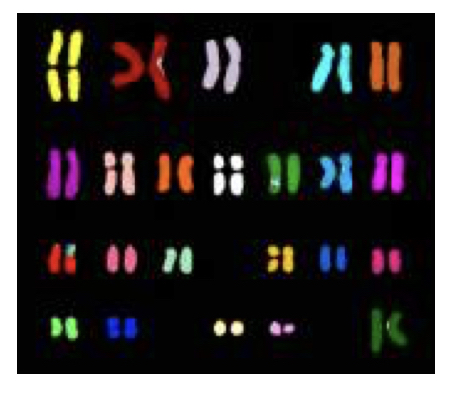Using a combination of different colored probes every chromosome present in a genome can be visualized differently.
Talk of the topic: In the present article, we are discussing a general introduction to karyotyping, what spectral karyotyping is, and what is its principle and how it works. Also in the last segment of this article, we will discuss the applications and limitations of the present technique.
Related article: What is karyotyping?
Introduction:
We know so many things regarding karyotyping, right! Because the present website is dedicatedly designed in such a way that all the topics around karyotyping are covered.
Here we have explained the entire process, materials, chemical, protocols, applications and limitations of karyotyping.
The karyotyping is a cytogenetic method or technique, a conventional and laborious method to study chromosomes. Here we are doing cell culture, incubation, cell harvesting and metaphase preparation to separate chromosomes.
We can find a change in the structure and number of chromosomes using the present technique however, not all the chromosomal or karyotyping abnormalities can be identified by it.
By performing various banding techniques we give identity to chromosomes for identification. For Instance, by a GTG banding different banding patterns of euchromatin and heterochromatin regions are developed. And we can separate different pairs of chromosomes.
Through different brands are developed by protein digestion, all chromosomes are stained with a single color but what if I tell you that we can paint all chromosomes with different colors!
Sounds crazy but it’s true, we can paint different pairs of chromosomes using a specialized and state of the art cytogenetic method known as spectral karyotyping.
What is spectral karyotyping?
The spectral karyotyping often known as SKY is used to paint or manipulate chromosomes in order to develop different colors using various colored probes.
Now understand those who are associated with cytogenetics that the method is not a true karyotyping method, we can say, it a modification of FISH- Fluorescence in situ hybridization method.
Various structural and numerical chromosomal alterations which can’t be studied in conventional karyotyping can be determined by SKY.
The present method was developed by Schrock E and coworkers in 1996. Using 24 different color probes they had karyotyped rat and human chromosomes.
The spectral karyotyping method is majorly used to study leukemia chromosomes.
Principle of SKY:
The SKY or spectral karyotyping is a molecular cytogenetic technique work on the principle of FISH, however, SKY utilizes metaphase chromosomes unlike the FISH.
The present method is a hybridization based technique in which each pair of chromosomes are colored with different colored fluorochrome and hybridized with probes in a single reaction.
Different colored chromosomes are observed, resultantly.

Steps and Procedure:
- Preparation of metaphase chromosomes
- Preparing flow-shorted human chromosomes
- Labeling of chromosomes
- Hybridization
- Detection of hybridization
- Results analysis
The first step in spectral karyotyping is the preparation of metaphase chromosomes. The process is the same as conventional karyotyping. A slide of well separated metaphase is prepared and stored.
In the next step, flow-sorted chromosomes are prepared using the degenerate oligo-primed amplification (DOP-PCR) method.
Each chromosome pair is labeled with fluorochromes of various colors. Simultaneously, SKY probe mixtures are also prepared.
Both probes and chromosomes are applied for hybridization at 37C for 24 to 72 hours. After the hybridization occurs, all the unbounded probes are removed by washing.
A spectral image of a karyotype is captured by the charge-coupled-device. Using the optical microscopy different pairs of chromosomes are observed under the microscope.
Related article: karyotyping vs karyotype.
Applications of SKY:
The sky is a kind of molecular cytogenetic technique and a combination of FISH and conventional karyotyping so it is obvious that there are a wide range of advantages and applications it may serve.
The present technique is routinely used for leukemia karyotyping and detecting chromosomal abnormalities related to leukemia.
It is also used in studying complex rearrangements and marker chromosomes.
Advantages of SKY:
- It can detect interchromosomal rearrangements between 500 to 2000kb.
- It can detect balance as well as unbalanced translocations.
- It can also be used for aneuploidy studies.
Limitations:
A genomic region less than 5Mb can’t be encountered by spectral karyotyping.
Same chromosomal inversion, duplications and deletions can’t be detected.
- Is the Y chromosome really disappearing- let’s findout a scientific answer
- 5p deletion syndrome: Why do they cry like a cat?
- Chromosome 2: Genes, Abnormalities and Disorders
- Importance of Metaphase Chromosomes in Karyotyping
- Are Chromosomal/ karyotyping Abnormalities Permanent or Temporary?
Conclusion:
Frankly, speaking I don’t have enough experience on SKY, actually, I never worked on it. So I can’t tell you how practically it works.
Still, I can say it is a very good option to karyotype a leukemia sample. Abnormalities associated with leukemia can be detected by SKY precisely.



Excellent information…